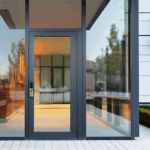After last Friday’s post about pocket doors, several people asked for more information about this application. Here are the answers to some frequently asked questions:
a) “I thought a pocket door slid into a pocket. Can swinging doors also be called ‘pocket doors’?”
Nobody ever said hardware is easy (or it would be called easyware!). There are two types of pocket doors – one is a sliding door that “disappears” when it slides into a pocket. Well, they used to disappear…now sliding pocket doors have to project out of the pocket when the hardware needs to be accessible. The doors in the photos are another type of pocket door, which swings open into a pocket so that it’s flush with the corridor wall when in the hold-open position.
b) “What’s the purpose of a pocket pivot?”
You may be familiar with offset pivots and center pivots, which are pivot sets that include pivots mounted at the top and bottom of the door. Pocket pivots are not like those pivot sets (again – it’s hardware). Pocket pivots are used instead of hinges on swinging pocket doors, to swing the door completely out of the door opening. The push-side face of the door aligns with the frame rabbet, and (hopefully!) with the corridor wall.
c) “Why not just use swing-clear hinges instead of pocket pivots?”
Although swing-clear hinges do swing the door out of the opening, there is a gap between the edge of the door and the face of the frame when the door is open. With pocket pivots, there is almost no gap. I actually posted a photo of pocket doors on swing-clear hinges 9 years ago, and there is a photo of a pocket door hung on swing-clear hinges on this post about different types of hinges.
 d) “What’s holding the door open, and how does it close?”
d) “What’s holding the door open, and how does it close?”
I didn’t look behind the door while we were on the college tour, but normally these doors have wall-mounted magnetic holders which hold the doors open until they are released by actuation of the fire alarm. The closers are usually a special type that is mounted to the wall inside the pocket, with a track attached to the back of the door (the LCN 4000T is an example of this type of closer). This way, the closer is invisible when the door is in the hold-open position.
I wrote about pocket doors quite a while ago when I saw a pair at another university. Check out this post for more information on this application and the coordination required.
BTW…the person responsible for the details from last Friday’s post has come forward, and I’m sending him something really nice from the iDH prize vault. I’d like to share more photos of great applications like this, so if you have some good photos of your work with Allegion products that you want to share, please send them along. I especially love before and after photos. If I post the photos of your project on iDigHardware, I’ll send you something that will make your coworkers green with envy. 🙂
You need to login or register to bookmark/favorite this content.





Thanks Lori! It’s nice to see something done right.
Most of us in the field spend our days sorting out problems caused by improper design, installation, incorrect hardware and abuse.
It’s a treat to see a job done right for a change!
Kudos to the architect (More likely the detailer, and not the “big picture” guys), the spec writers, the builders and hardware installers!
I would bet that the maintenance and repair people never have to do any work on those doors.
Here is a link to a pdf I found showing installation instructions for the Ives 91105F Pocket Pivot for wood door/metal frame and metal door/metal frame applications: https://us.allegion.com/content/dam/allegion-us-2/web-documents-2/InstallInstructions/Ives_91105F_Pocket_Pivot_Installation_Instructions_107577.pdf
That is something I have not seen previously in my 75 years.
Now if they only used Von Duprin InPact exit devices, would hve bee a much cleaner look…..